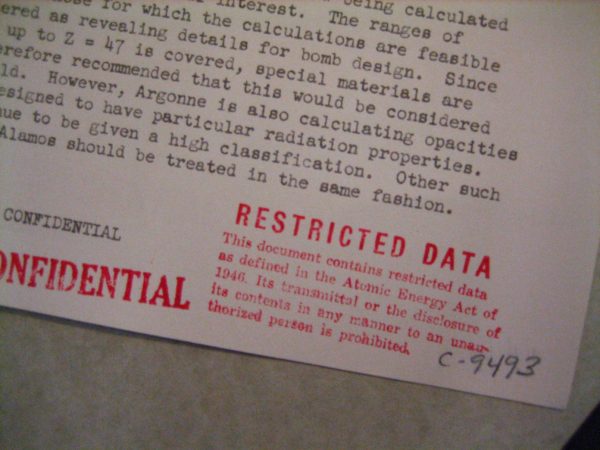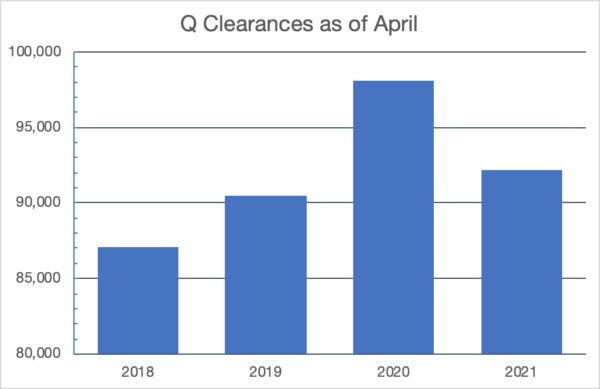The Q Clearance is the enigmatically-named security clearance created to allow access Restricted Data, the legal category for nuclear secrets in the United States (after which my book is named). It is issued by the the US Department of Energy, and requires a single-scope background investigation (originally by the FBI), with the same requirements as a Top Secret clearance, and keeping it requires being re-investigated every 5 years.

A Restricted Data stamp from a document from the 1940s. If you don’t have a Q Clearance, you’re not supposed to see things like this. Don’t worry, this one was declassified. Strictly speaking, they are supposed to cross the stamps out once they declassify them. But they didn’t always do that consistently. I photographed this one at the NARA Archives II facility. You can see more photos I’ve taken of secrecy stamps, if that sort of thing piques your interest.
So how many people currently have Q clearances? Someone asked me this a year ago and I realized that not only did I not know, but I didn’t really have a great way to even estimate it. So I did the natural thing and filed a Freedom of Information Act request to the Department of Energy and asked them.
And today, they got back to me with this simple table:
April 2018 – 87,113
April 2019 – 90,454
April 2020 – 98,103
April 2021 – 92,177
Which is somewhat interesting. First, I guess that’s more than I would have guessed, but again, I didn’t have a great place to start for guessing. I knew, from Dana Priest and William Arkin’s Top Secret America that a decade ago, 850,000 Americans had a Top Secret clearance — a remarkable number. As of 2019, that’s up to 1.25 million. 1 That Q clearances would be about 10% of that seems reasonable once I consider it, but if you had told me it was 5%, or 15%, I also might have thought that was reasonable, too, in the absence of information.
Second, there’s an interesting amount of fluctuation there. From 2018 to 2019, it grew by 3,341 people, but then the next year it grew by 7,649 people, but then it dropped by almost 6,000 people. That strikes me as a pretty impressive amount of variance. A nearly 10% gain, followed by a 6% loss. But again, I don’t have any more data than this tiny snapshot, so it is hard to say more about it.
Anyway, I thought people would be interested (and wanted to have an “answer” out there in case anyone else Googled this question in the future).

Obligatory “quick Excel graph that is not really necessary since we are talking about a whopping four data points.”
The most amusing thing about the Q Clearance, as an aside, is that while its name sounds so enigmatic and mysterious, its actual origins are aggressively mundane. During the latter part of the Manhattan Project, they created a new form called the Personnel Security Questionnaire that would be the basis of their background checks. When the Atomic Energy Commission took over administration of the US nuclear complex, they inherited the same form. In figuring out early clearance levels, they decided that maybe they ought to just call them P, S, and Q, after the PSQ form.
“P” would be for people who didn’t need access to Restricted Data and had no access to it at all; “S” was for frequent visitors to AEC installations who didn’t need access to Restricted Data but still needed to be in places where it might be found; “Q” was for people who needed access to Restricted Data. So instead of being some shadowy name, its name is literally taken from a form. Like many secret matters, the reality is far less interesting once you get the full story. 2
- Thanks to Steve Aftergood at FAS for sending me this document![↩]
- The P designation is still used today (but not called P Clearance, because it is not a clearance, strictly speaking, but an “approval”). I suspect they retired S at some point because it is easy to confuse with someone who is cleared for Secret information.[↩]


Interesting, but this doesn’t explain the L Clearance which is Confidential with access to some Secret information (just as a Q Clearance has access to some Top Secret information). I have had both, as well as no clearance at all, in my 38 years at Hanford. And, if there was a P and S clearance, it was before my time (which started in 1980) because it’s only ever been L or Q for cleared personnel. At one time they were reclassified as 2, 3, or 5 (if my memory holds) with 3 being the same as a Q and 5 as an L. I remember some top dogs at N Reactor had 2s but most everyone else had a 3. 5 or L was usually a first step in getting through the clearance process; virtually everyone at the reactor eventually had a Q, although probably 95% of them never once saw anything classified. After plutonium production halted in 1987 an effort was made to downgrade clearances–I went to an L in the early 90s, back to a Q for a while, then down to an L and finally one sad day I got called in and had to turn in my L badge for a plain old “contractor” badge. There just wasn’t a need for so many cleared people any more.
L Clearance was created in the 1950s so that people who needed a very “limited” sort of access to RD could get it, originally for the purpose of allowing more private industrial investment in nuclear technology.
Interesting. I had a Secret/Restricted Data clearance in the early 70’s. Don’t remember anything about a Q clearance. We filled out papers for a CNWDI clearance in munitions tech school, but it was determined we didn’t need it, so nothing came of it.
My question would be does this include people with a DoD clearance and access to FRD/RD/CNWDI? If you’ve got a TS/SCI and fill out the form for RD access, you’ve essentially got the equivalent of a Q, although I don’t know how that relates to the various sigmas.
I suspect this is just for honest-to-god Q clearances (because it would be unusual for the DOE to do more work than I asked them to do).
I wonder if the drop in 2021 is the change in presidential administration. Biden comes in with his own national security folks and pushes out a bunch of guys from the old administration. Those guys lose their clearance since they don’t need it anymore, and Biden’s guys go into the queue to get their own clearances. Seems like that would be the expected pattern, a drop in the first year or two of a new administration and then a slow rise as the new administration’s guys get their clearances.
My guess is that it is not as linked to political administrations as one might imagine — only because most of the people who have these kinds of clearances are not in political-appointee jobs, and in general the everyday operation of the US government is less linked to that sort of thing than the newspapers would have you imagine. (That does not mean there aren’t shifts over time in who works where — but they aren’t overnight changes.) That being said, I don’t know what accounts for the fluctuations, or if they are just normal movements of hirings/retirements/firings/etc. Across a very large infrastructure there are lots of reasons people move around.
I recall that in recent years, before I retired in 2020, there was a backlog of security clearances to be processed. That may have affected the number of people with clearances.